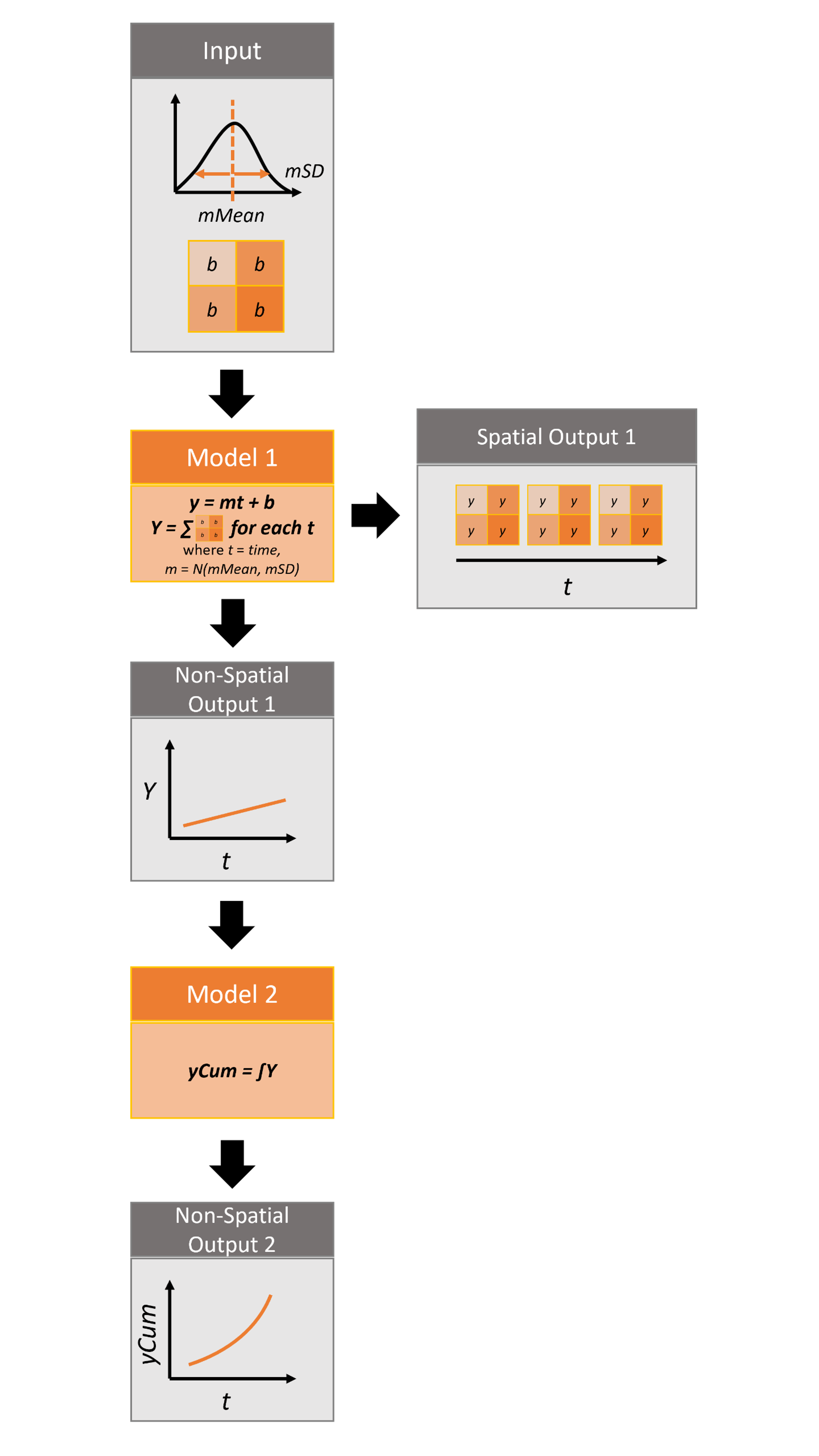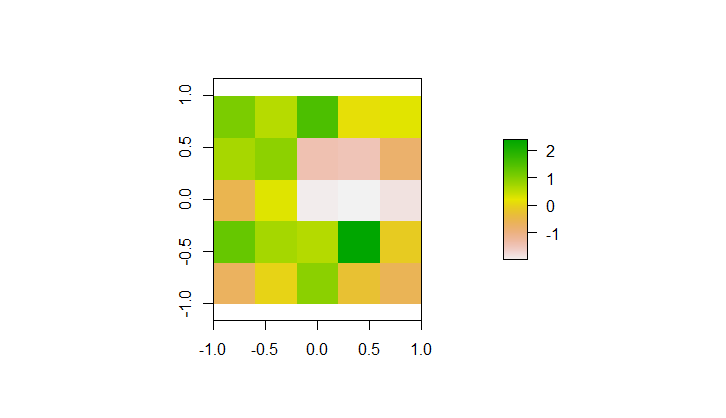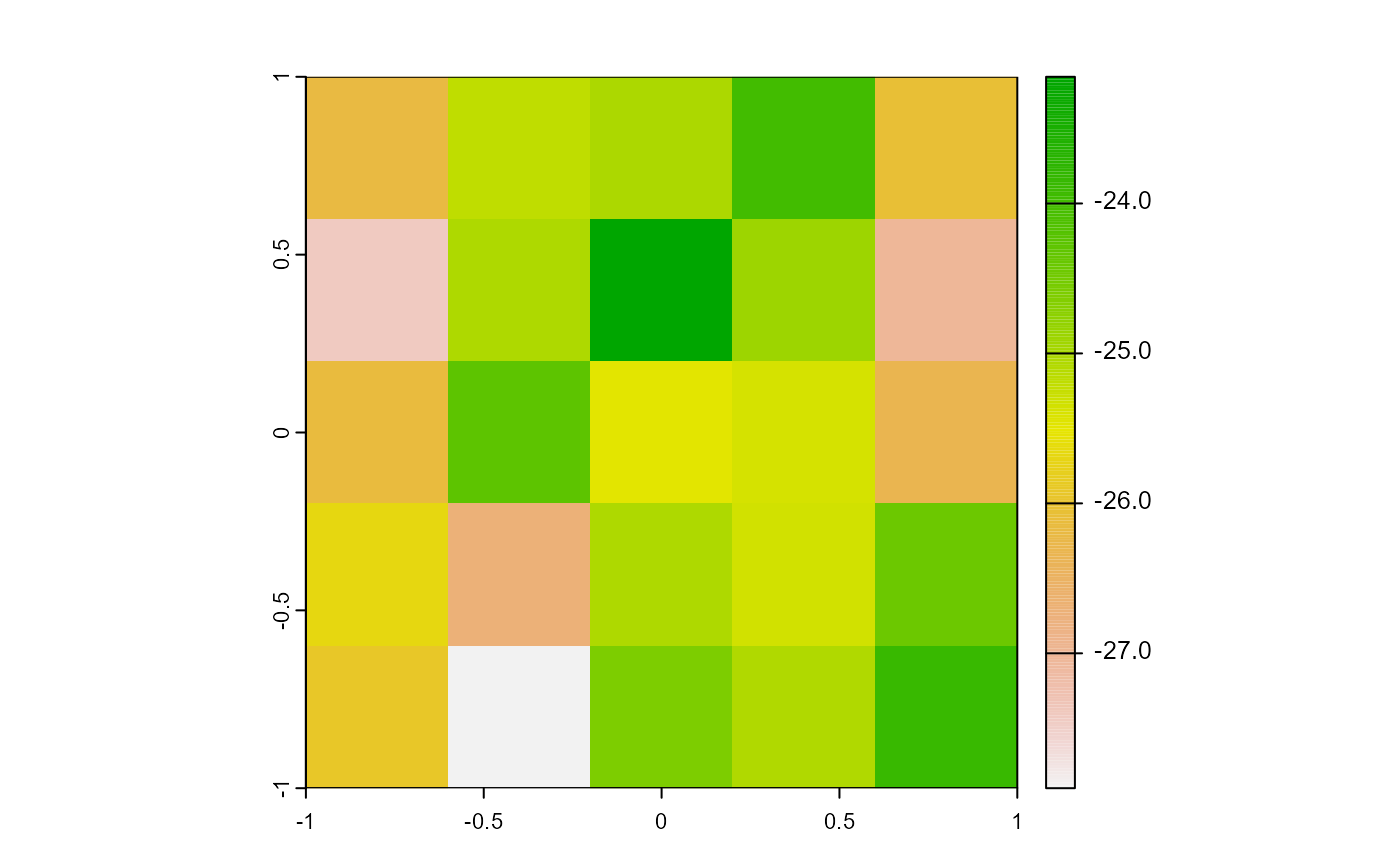rsyncrosim: introduction to spatial
data
Source: vignettes/a04_rsyncrosim_vignette_spatial.Rmd
a04_rsyncrosim_vignette_spatial.RmdThis vignette will cover incorporating spatial data into SyncroSim
models using the rsyncrosim package within the
SyncroSim software
framework. For an overview of
SyncroSim and
rsyncrosim,
as well as a basic usage tutorial for rsyncrosim, see the
Introduction
to rsyncrosim vignette. To learn how to use iterations
in the rsyncrosim interface, see the
rsyncrosim:
introduction to uncertainty vignette. To learn how to link models
using pipelines in the rsyncrosim interface, see the
rsyncrosim:
introduction to pipelines vignette.
SyncroSim Package: helloworldSpatial
To demonstrate how to use spatial data in the rsyncrosim
interface, we will be using the
helloworldSpatial
SyncroSim package. helloworldSpatial was designed to be a
simple package to show off some key functionalities of SyncroSim,
including the ability to use both spatial and non-spatial data.
The package takes 3 inputs, mMean, mSD, and a spatial raster file of intercept (b) values. For each iteration, a value m, representing the slope, is sampled from a normal distribution with mean of mMean and standard deviation of mSD. These values are run through 2 models to produce both spatial and non-spatial outputs.

For more details on the different features of the
helloworldSpatial SyncroSim package, consult the SyncroSim
Enhancing
a Package: Integrating Spatial Data tutorial.
Setup
Install SyncroSim
Before using rsyncrosim you will first need to
download and
install the SyncroSim software. Versions of SyncroSim exist for both
Windows and Linux.
Installing and loading R packages
You will need to install the rsyncrosim R package,
either using
CRAN or from
the rsyncrosim
GitHub
repository. Versions of rsyncrosim are available for
both Windows and Linux. You may need to install the raster
and rgdal packages from CRAN as well.
In a new R script, load the necessary packages. This includes the
rsyncrosim and terra R packages.
# Load R packages
library(rsyncrosim) # package for working with SyncroSim## Warning: package 'rsyncrosim' was built under R version 4.3.3## terra 1.7.55##
## Attaching package: 'terra'## The following object is masked from 'package:rsyncrosim':
##
## projectConnecting R to SyncroSim using session()
Finish setting up the R environment for the rsyncrosim
workflow by creating a SyncroSim Session object. Use the
session() function to connect R to your installed copy of
the SyncroSim software.
mySession <- session("path/to/install_folder") # Create a Session based SyncroSim install folder
mySession <- session() # Using default install folder (Windows only)
mySession # Displays the Session object## class : Session
## filepath [character]: C:/Program Files/SyncroSim
## silent [logical] : TRUE
## printCmd [logical] : FALSE
## condaFilepath [NULL]:Use the version() function to ensure you are using the
latest version of SyncroSim.
version(mySession)## [1] "2.5.11"Installing SyncroSim packages using addPackage()
Install helloworldSpatial using the
rynscrosim function addPackage(). This
function takes a package name as input and then queries the SyncroSim
package server for the specified package.
# Install helloworldSpatial
addPackage("helloworldSpatial")## Package <helloworldSpatial> installedhelloworldSpatial should now be included in the package
list returned by the package() function in
rsyncrosim:
# Get list of installed packages
package()## name description version
## 1 helloworldSpatial Example demonstrating how to use spatial data 1.1.0
## location status
## 1 C:\\Users\\sarah\\SyncroSim\\Packages\\helloworldSpatial OKCreate a modeling workflow
When creating a new modeling workflow from scratch, we need to create objects of the following scopes:
For more information on these scopes, see the Introduction
to rsyncrosim vignette.
Set up Library, Project, and Scenario
# Create a new Library
myLibrary <- ssimLibrary(name = "helloworldLibrary.ssim",
session = mySession,
package = "helloworldSpatial",
overwrite = TRUE)
# Open the default Project
myProject = rsyncrosim::project(ssimObject = myLibrary, project = "Definitions")
# Create a new Scenario (associated with the default Project)
myScenario = scenario(ssimObject = myProject, scenario = "My spatial scenario")View model inputs using datasheet()
View the Datasheets associated with your new Scenario using the
datasheet() function from rsyncrosim.
# View all Datasheets associated with a Library, Project, or Scenario
datasheet(myScenario)## scope name displayName
## 1 library core_Backup Backup
## 2 library core_CondaConfig Conda Configuration
## 3 library core_JlConfig Julia Configuration
## 4 library core_LNGPackage Last Known Good Packages
## 5 library core_Multiprocessing Multiprocessing
## 6 library core_Options Options
## 7 library core_ProcessorGroupOption Processor Group Options
## 8 library core_ProcessorGroupValue Processor Group Values
## 9 library core_PyConfig Python Configuration
## 10 library core_RConfig R Configuration
## 11 library core_Settings Settings
## 12 library core_SysFolder Folders
## 13 library corestime_Options Spatial Options
## 14 project core_AutoGenTag Auto Generation Tags
## 15 project core_RunSchedulerOption Run Scheduler Options
## 16 project core_RunSchedulerScenario Run Scheduler Scenarios
## 17 project core_StageName Stage Groups
## 18 project core_StageValue Stages by Group
## 19 project core_Transformer Stages
## 20 project corestime_Charts Charts
## 21 project corestime_DistributionType Distributions
## 22 project corestime_ExternalVariableType External Variables
## 23 project corestime_MapFacet Map Faceting
## 24 project corestime_Maps Maps
## 25 scenario core_AutoGenTagValue Auto Generation Tag Values
## 26 scenario core_Pipeline Pipeline
## 27 scenario corestime_DistributionValue Distributions
## 28 scenario corestime_External External
## 29 scenario corestime_ExternalVariableValue External Variables
## 30 scenario corestime_Multiprocessing Spatial Multiprocessing
## 31 scenario helloworldSpatial_InputDatasheet InputDatasheet
## 32 scenario helloworldSpatial_IntermediateDatasheet IntermediateDatasheet
## 33 scenario helloworldSpatial_OutputDatasheet OutputDatasheet
## 34 scenario helloworldSpatial_RunControl Run ControlFrom the list of Datasheets above, we can see that there are four
Datasheets specific to the helloworldSpatial package,
including an Input Datasheet, an Intermediate Datasheet, an Output
Datasheet, and a Run Control Datasheet.
Configure model inputs using datasheet() and
addRow()
Currently our input Scenario Datasheets are empty! We need to add
some values to our input Datasheet (InputDatasheet) and run
control Datasheet (RunControl) so we can run our model.
Since this package also uses pipelines, we also need to add some
information to the core Pipeline Datasheet to specify which
models are run in which order. For more information on using pipelines,
see the rsyncrosim:
introduction to pipelines vignette and the SyncroSim
Enhancing
a Package: Linking Models tutorial.
Input Datasheet
First, assign the contents of the input Datasheet to a new data frame
variable using datasheet(), then check the columns that
need input values.
# Load input Datasheet to a new R data frame
myInputDataframe <- datasheet(myScenario,
name = "helloworldSpatial_InputDatasheet")
# Check the columns of the input data frame
str(myInputDataframe)## 'data.frame': 0 obs. of 3 variables:
## $ mMean : num
## $ mSD : num
## $ InterceptRasterFile: chrThe input Datasheet requires three values:
-
mMean: the mean of a normal distribution that will determine the slope of the linear equation. -
mSD: the standard deviation of a normal distribution that will determine the slope of the linear equation. -
InterceptRasterFile: the file path to a raster image, in which each cell of the image will be an intercept in the linear equation.
In this example, the external file we are using for the
InterceptRasterFile is a simple 5x5 raster TIF file
generated using the raster package in R. The file used in
this vignette can be found
here.

Add these values to a new data frame, then use the
addRow() function from rsyncrosim to update
the input data frame
# Create input data and add it to the input data frame
myInputRow <- data.frame(mMean = 0, mSD = 4,
InterceptRasterFile = "path/to/input-raster.tif")
myInputDataframe <- addRow(myInputDataframe, myInputRow)
# Check values
myInputDataframe## mMean mSD InterceptRasterFile
## 1 0 4 path/to/input-raster.tifFinally, save the updated R data frame to a SyncroSim Datasheet using
saveDatasheet().
# Save input R data frame as a SyncroSim Datasheet
saveDatasheet(ssimObject = myScenario, data = myInputDataframe,
name = "helloworldSpatial_InputDatasheet")## Datasheet <helloworldSpatial_InputDatasheet> savedRunControl Datasheet
The RunControl Datasheet sets the number of iterations
and the minimum and maximum time steps for our model. We’ll assign the
contents of this Datasheet to a new data frame variable as well and then
add then update the information in the data frame using
addRow(). We need to specify data for the following four
columns:
-
MaximumIteration: total number of iterations to run the model for. -
MinimumTimestep: the starting time point of the simulation. -
MaximumTimestep: the end time point of the simulation.
Note: A fourth hidden column, MinimumIteration,
also exists in the RunControl Datasheet (default=1).
# Load RunControl Datasheet to an R data frame
runSettings <- datasheet(myScenario, name = "helloworldSpatial_RunControl")
# Check the columns of the run control data frame
str(runSettings)## 'data.frame': 0 obs. of 3 variables:
## $ MaximumIteration: num
## $ MinimumTimestep : num
## $ MaximumTimestep : num
# Create RunControl data and add it to the RunControl data frame
runSettingsRow <- data.frame(MaximumIteration = 5,
MinimumTimestep = 1,
MaximumTimestep = 10)
runSettings <- addRow(runSettings, runSettingsRow)
# Check values
runSettings## MaximumIteration MinimumTimestep MaximumTimestep
## 1 5 1 10
# Save run control R data frame to a SyncroSim Datasheet
saveDatasheet(ssimObject = myScenario, data = runSettings,
name = "helloworldSpatial_RunControl")## Datasheet <helloworldSpatial_RunControl> savedPipeline Datasheet
The helloworldSpatial package also makes use of
pipelines to link the output of one model to the input of a second
model. To learn more about pipelines, see the rsyncrosim:
introduction to pipelines vignette and the SyncroSim
Enhancing
a Package: Linking Models tutorial.
To implement pipelines in our package, we need to specify the order
in which to run the Transformers (i.e. models) in our pipeline by
editing the Pipeline Datasheet. The Pipeline
Datasheet is part of the built-in SyncroSim core, so we access it using
the “core_” prefix with the datasheet() function. From
viewing the structure of the Pipeline Datasheet we know
that the StageNameID is a factor with two levels: “First
Model” and “Second Model”. We will set the data for this Datasheet such
that “First Model” is run first, then “Second Model”. This way, the
output from “First Model” is used as the input for “Second Model”.
# Load Pipeline Datasheet to an R data frame
myPipelineDataframe <- datasheet(myScenario, name = "core_Pipeline")
# Check the columns of the Pipeline data frame
str(myPipelineDataframe)## 'data.frame': 0 obs. of 2 variables:
## $ StageNameID: Factor w/ 2 levels "First Model",..:
## $ RunOrder : num
# Create Pipeline data and add it to the Pipeline data frame
myPipelineRow <- data.frame(StageNameID = c("First Model", "Second Model"),
RunOrder = c(1, 2))
myPipelineDataframe <- addRow(myPipelineDataframe, myPipelineRow)
# Check values
myPipelineDataframe## StageNameID RunOrder
## 1 First Model 1
## 2 Second Model 2
# Save Pipeline R data frame to a SyncroSim Datasheet
saveDatasheet(ssimObject = myScenario, data = myPipelineDataframe,
name = "core_Pipeline")## Datasheet <core_Pipeline> savedRun Scenarios
Setting run parameters with run()
We will now run our Scenario using the run() function in
rsyncrosim. If we have a large modeling workflow and we
want to parallelize the run using multiprocessing, we can set the
jobs argument to be a value greater than one.
# Run the first Scenario we created
myResultScenario <- run(myScenario, jobs = 5)## [1] "Running scenario [1] My spatial scenario"After the Scenario has been run, a Results Scenario is created that contains results in the output Datasheets.
View results
The next step is to view the output Datasheets added to the Result Scenario when it was run.
Viewing non-spatial results with datasheet()
First, we will view the non-spatial results within the Results
Scenarios. For each step in the pipeline, We can load the result tables
using the datasheet() function.
# Load results of first Transformer in Pipeline
resultsSummary <- datasheet(myResultScenario,
name = "helloworldSpatial_IntermediateDatasheet")
# View results table of first Transformer in Pipeline
head(resultsSummary)## Iteration Timestep y OutputRasterFile
## 1 1 1 -130.7026 rasterMap_iter1_ts1.tif
## 2 1 2 -257.0712 rasterMap_iter1_ts2.tif
## 3 1 3 -383.4399 rasterMap_iter1_ts3.tif
## 4 1 4 -509.8085 rasterMap_iter1_ts4.tif
## 5 1 5 -636.1771 rasterMap_iter1_ts5.tif
## 6 1 6 -762.5457 rasterMap_iter1_ts6.tif
# Load results of second Transformer in Pipeline
resultsSummary2 <- datasheet(myResultScenario,
name = "helloworldSpatial_OutputDatasheet")
# View results table of second Transformer in Pipeline
head(resultsSummary2)## Iteration Timestep yCum
## 1 1 1 -130.7026
## 2 1 2 -387.7738
## 3 1 3 -771.2137
## 4 1 4 -1281.0222
## 5 1 5 -1917.1993
## 6 1 6 -2679.7450From viewing these Datasheets, we can see that the spatial output is
contained within the IntermediateDatasheet, in the column
called OutputRasterFile.
Viewing spatial results with datasheetSpatRaster()
For spatial results, we want to load the results as raster images. To
do this, we will use the datasheetSpatRaster() function
from rsyncrosim. The first argument is the result Scenario
object. Next, we specify the name of the Datasheet containing raster
images using the datasheet argument, and the column
pertaining to the raster images using the column argument.
The results contain many raster images, since we have a raster for each
combination of iteration and time step. We can use the
iteration and timestep arguments to specify a
single raster image or a subset of raster images we want to view.
# Load raster files for first result Scenario with time step and iteration
rasterMaps <- datasheetSpatRaster(
myResultScenario,
datasheet = "helloworldSpatial_IntermediateDatasheet",
column = "OutputRasterFile",
iteration = 1,
timestep = 5
)
# View results
rasterMaps## class : SpatRaster
## dimensions : 5, 5, 1 (nrow, ncol, nlyr)
## resolution : 0.4, 0.4 (x, y)
## extent : -1, 1, -1, 1 (xmin, xmax, ymin, ymax)
## coord. ref. : lon/lat WGS 84
## source : rasterMap_iter1_ts5.tif
## name : rasterMap_iter1_ts5
## min value : -27.89954
## max value : -23.15529
plot(rasterMaps[[1]])
Viewing spatial results in the SyncroSim Windows User Interface
To create maps using the Results Scenario we just generated, open the
current Library in the User Interface and sync the updates from
rsyncrosim using the “refresh” button in the upper toolbar.
All the updates made in rsyncrosim should appear in the
User Interface. We can now add the Results Scenario to the Results
Viewer and create our maps. For more information on generating map in
the User Interface, see the SyncroSim tutorials on
creating
and
customizing
maps

rsyncrosim with the SyncroSim
Windows User Interface to map spatial data